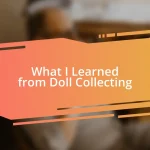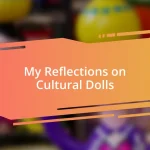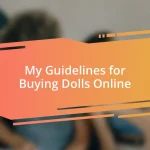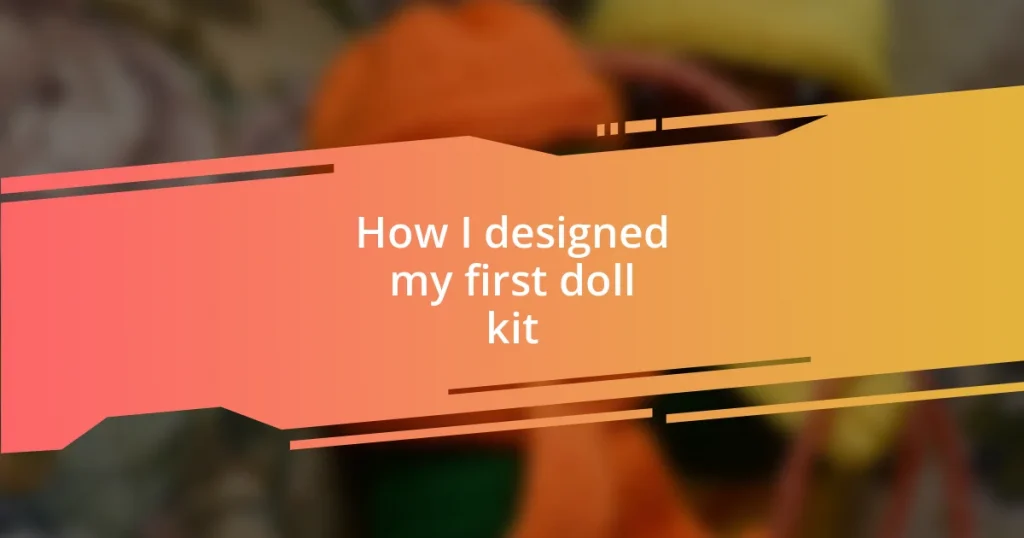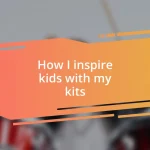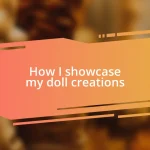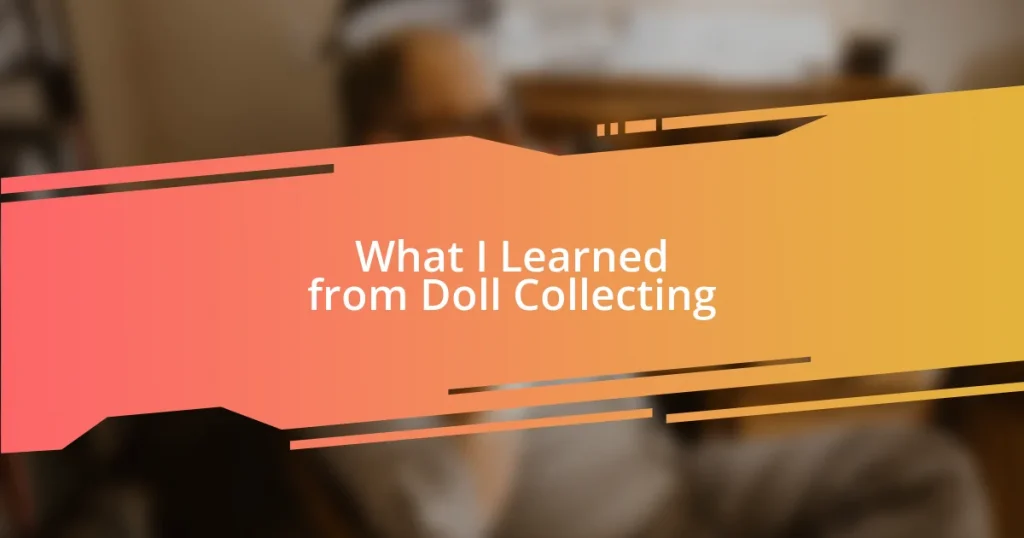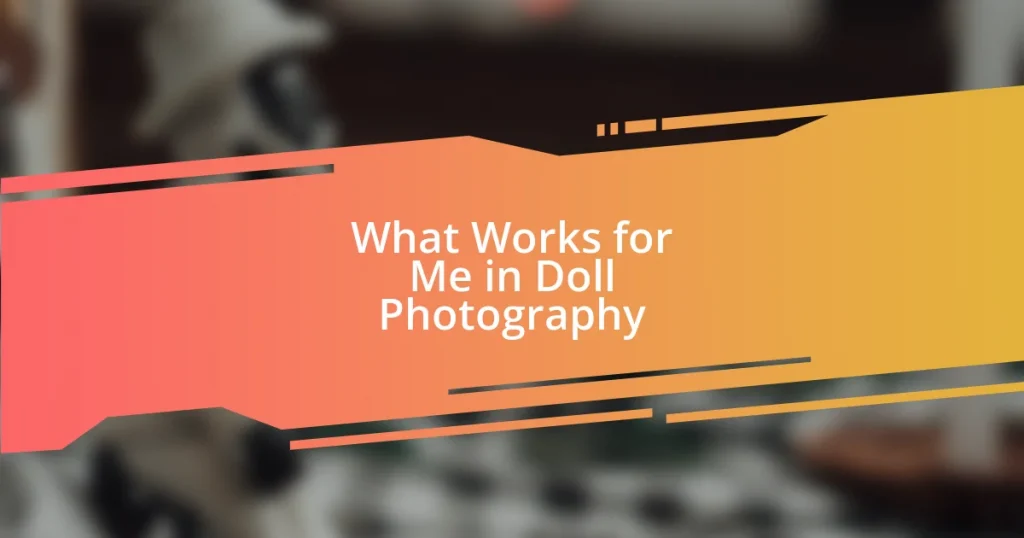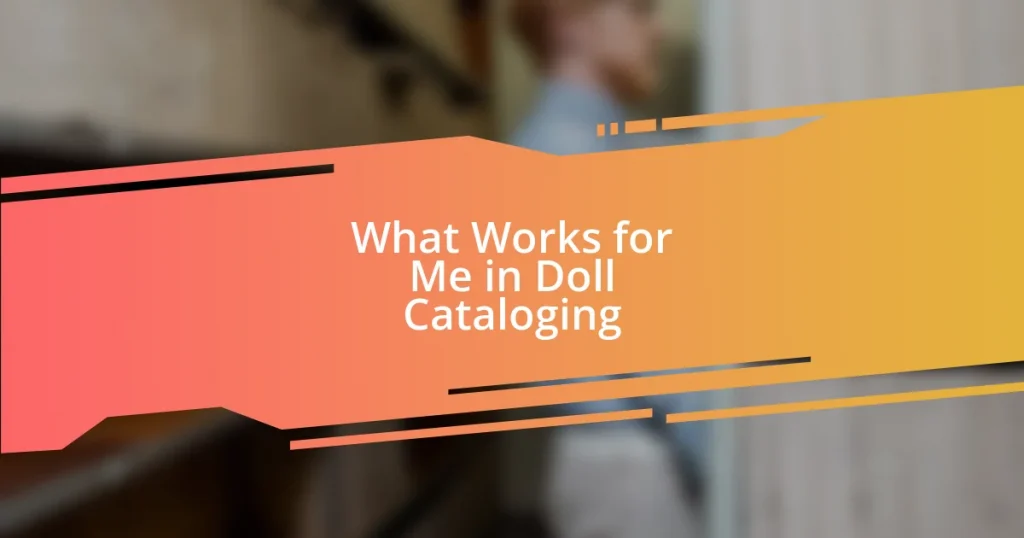Key takeaways:
- The doll kit concept emphasizes personalization and storytelling through design choices and materials, evoking emotions and nostalgia.
- Researching popular doll designs reveals trends influenced by culture, sustainability, customization, and character inspirations from media.
- Effective marketing involves authentic engagement on social media, collaborations with artists, and creating valuable content that resonates with the audience.
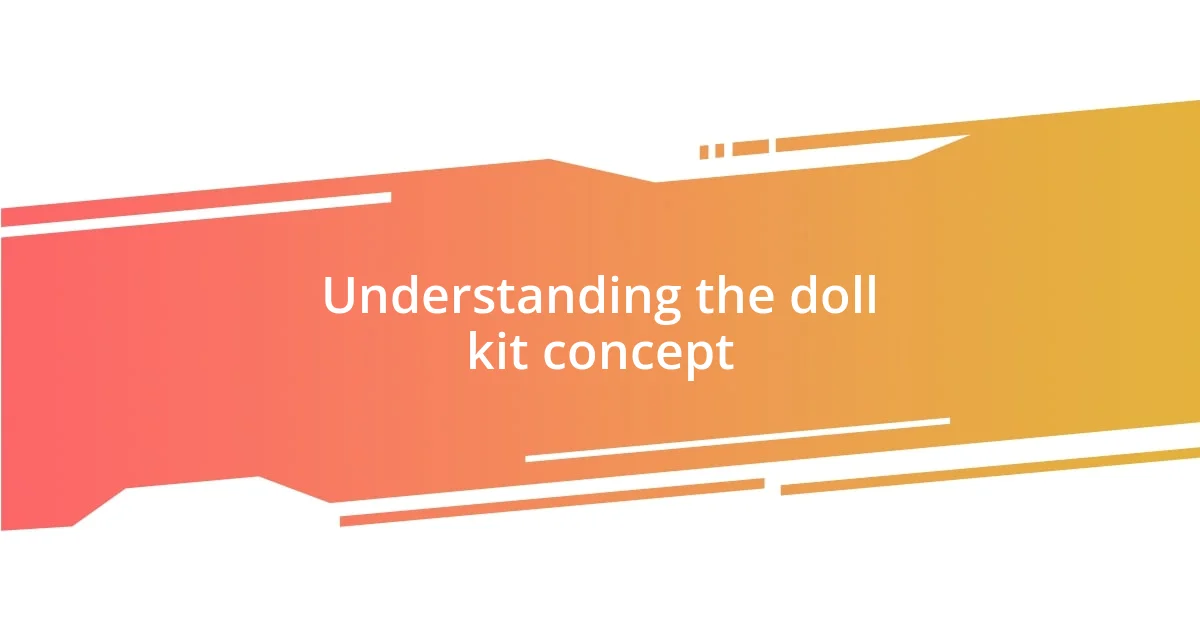
Understanding the doll kit concept
The doll kit concept is truly fascinating because it transforms a simple idea into a creative journey. When I first encountered a doll kit, I was amazed at how many choices were available—from the materials to the design elements. I remember feeling an exhilarating rush of possibilities as I thought about personalizing each doll to tell a unique story.
In my experience, creating a doll kit feels like sculpting an identity. Each component, whether it’s the eyes, hair, or outfit, has the potential to imbue the doll with personality and character. Have you ever considered how a simple change in a doll’s hairstyle could evoke different emotions or narratives? It’s a powerful testament to how our choices as designers can resonate on a deeper level.
Moreover, embarking on this creative endeavor invites a wonderful sense of nostalgia. I recall the joy of making dolls with my grandmother, each stitch imbued with memories and emotions. That connection enhances the meaning behind a doll kit; it’s not just about assembling parts—it’s about crafting experiences and cherishing the legacy of creativity we pass down.

Researching popular doll designs
Researching popular doll designs helped me understand the trends that resonate with different audiences. I dove into various online communities and forums, soaking up the creativity and innovation that fueled these designs. It was eye-opening to see how certain styles evoke nostalgia, while others embrace contemporary themes. I remember scrolling through social media and being utterly captivated by vibrant fabric choices and unique embellishments.
Here are some key aspects I discovered during my research:
- Cultural Influences: Dolls often reflect the culture they originate from, showcasing traditional clothing or hairstyles.
- Sustainable Choices: Eco-friendly materials are gaining traction, appealing to environmentally conscious creators and buyers.
- Customization Trends: Many designers now offer kits that allow for personal touches, catering to individual preferences.
- Character Inspirations: Popular media influences doll designs, with characters from movies and books shaping trends in doll aesthetics.
With these insights, I started envisioning how I could incorporate elements that not only drew from popular designs but also added my unique touch to showcase a distinct identity within my doll kit.
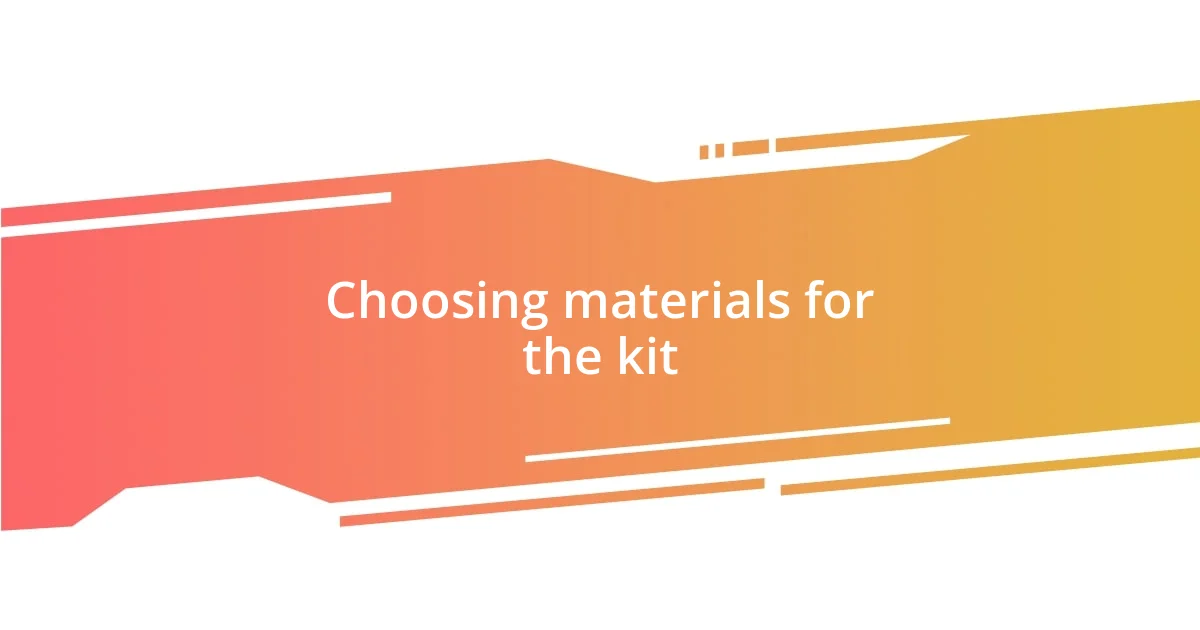
Choosing materials for the kit
Choosing the right materials for my doll kit was an exciting yet daunting task. I wanted to strike a balance between aesthetic appeal and durability. When I visited a local fabric store, I was captivated by the colorful array of textiles; I could almost envision how each fabric would transform into different doll outfits. Cotton, felt, and even eco-friendly fabrics caught my eye. I remember standing there, wondering how each choice would affect the final look and feel.
As I mulled over my selections, I considered the texture of the materials. Soft, plush fabrics offer a touchable quality, while stiffer ones maintain structure. I recall testing different fabrics by making small swatches, feeling the differences in my hands. There’s something special about choosing materials that resonate with the emotions I want my dolls to evoke. Do you remember picking fabric for a project as a child and how each texture told its own story? I sure do! It felt like I was reconnecting with that childhood excitement.
To summarize my choices, here’s a quick comparison of the materials I considered for the kit:
| Material | Properties |
|---|---|
| Cotton | Soft, breathable, easy to sew |
| Felt | Sturdy, no-fray edges, comes in vibrant colors |
| Eco-friendly Fabrics | Sustainable, varied textures, slightly more expensive |
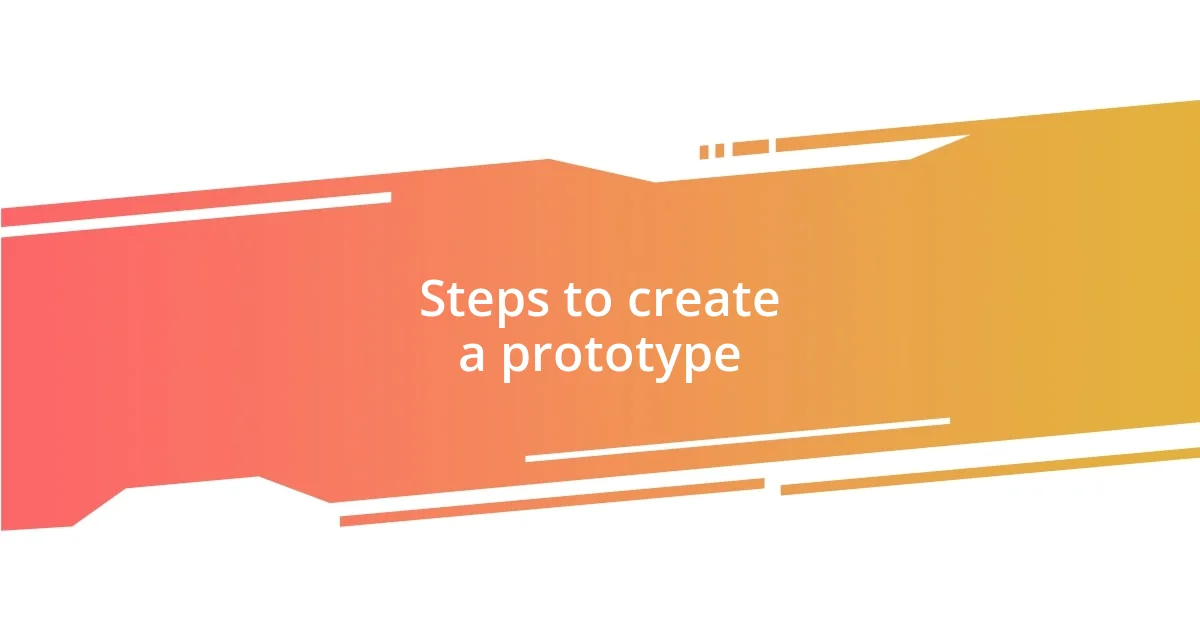
Steps to create a prototype
Creating a prototype is where the magic really starts to happen. I remember sketching my designs on a notepad, pouring my thoughts into each line and curve. It was like bringing my dolls to life on paper, fueled by the inspirations I gathered during my research. Each sketch didn’t just represent a doll; it captured a piece of my creative spirit aimed at connecting with future owners.
Once I settled on a design, I took to crafting a basic model. I cut out fabric pieces and began assembling them, and the first time I saw a doll taking shape, I felt an exhilarating rush. It reminded me of those moments in childhood when I put together my first puzzle—each part clicked into place, revealing a beautiful picture. Have you ever felt that thrill of creation? It’s a rush that’s hard to describe, but it keeps you coming back for more.
After constructing the initial model, I carefully assessed functionality and aesthetics. I asked myself questions like, “Does this doll move easily?” and “Is the design appealing?” This stage often requires tweaking and retesting. I can recall spending hours adjusting seams and proportions to achieve the perfect balance. Finding that sweet spot between design intention and practical reality is crucial for a successful prototype! Each alteration brought me closer to what I envisioned, as I embraced the learning curve that came with the process.
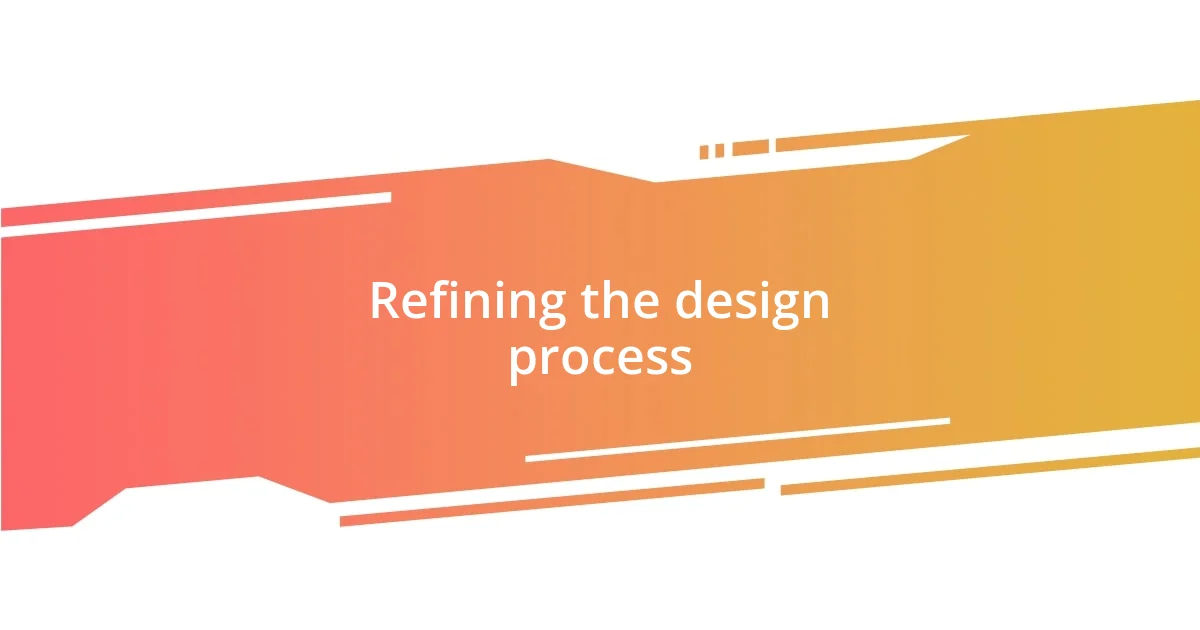
Refining the design process
Refining the design process took me on an unexpected journey of discovery. After creating my initial prototype, I found myself pouring over every detail, wondering what could be improved. It felt a bit like tuning a musical instrument; one small adjustment can create harmony. I vividly remember when I altered the arm shape, which made a world of difference in the doll’s ability to pose lifelike. Isn’t it fascinating how minor tweaks can lead to significant transformations?
As I entered the refinement phase, feedback became essential. I reached out to friends and fellow crafters, asking them to test the prototypes. It was nerve-wracking to let others see my work, but their fresh perspectives were invaluable. One friend pointed out that the neck needed to be slightly longer for a more graceful appearance. I hadn’t considered that possibility before, and it was a lightbulb moment for me. Have you ever had your vision sharpened by someone else’s viewpoint? It truly reinforced my belief in collaboration.
With each revision, I felt a deeper connection to my dolls. I remember making those small changes late into the night, sometimes leaving the workspace with paint-specked fingers. It was during those quiet hours that I discovered my true design philosophy: every doll is a vessel of emotion, and the refining process was not just about perfecting a physical item, but about bringing something meaningful into the world. How powerful is that realization? It’s moments like these that make the creative process incredibly rewarding.

Packaging and presentation tips
When it came to packaging my doll kit, I wanted every detail to reflect the creativity and emotion I poured into the dolls themselves. I remember sitting with a pile of craft paper, surrounded by paint swatches and fabric samples, contemplating how to create a presentation that would make someone feel a sense of joy and nostalgia at first glance. Have you ever opened a box and felt an instant rush of excitement? That’s what I aimed for—inspiring that feeling right from the moment my kit was unveiled.
Selecting the right materials was key. I chose biodegradable packaging to emphasize my commitment to sustainability. Crafting a whimsical box design with cheerful illustrations of the dolls was not just about aesthetics; I wanted it to tell a story. It reminded me of when I used to make my own dolls as a child, excitedly wrapping them as gifts. Those small touches, like including a printed card with a heartfelt message, helped create a personal connection, ensuring that the recipient felt valued and special. Isn’t it amazing how thoughtful details can turn ordinary objects into treasured keepsakes?
Finally, I focused on the unboxing experience, turning it into an event of its own. I remember experimenting with layers of tissue paper and placing an unexpected little trinket on top—a tiny charm that resonated with the doll’s theme. This not only delighted buyers but also made them feel like they were part of the unfolding story. What if you could turn the simple act of opening a package into a memorable experience? The goal was to spark joy and ignite creativity, making them eager to dive into the crafting process. Every effort I made to invest in the presentation paid off, aligning perfectly with the doll kits’ essence—capturing the playfulness and excitement of bringing a new creation into the world.
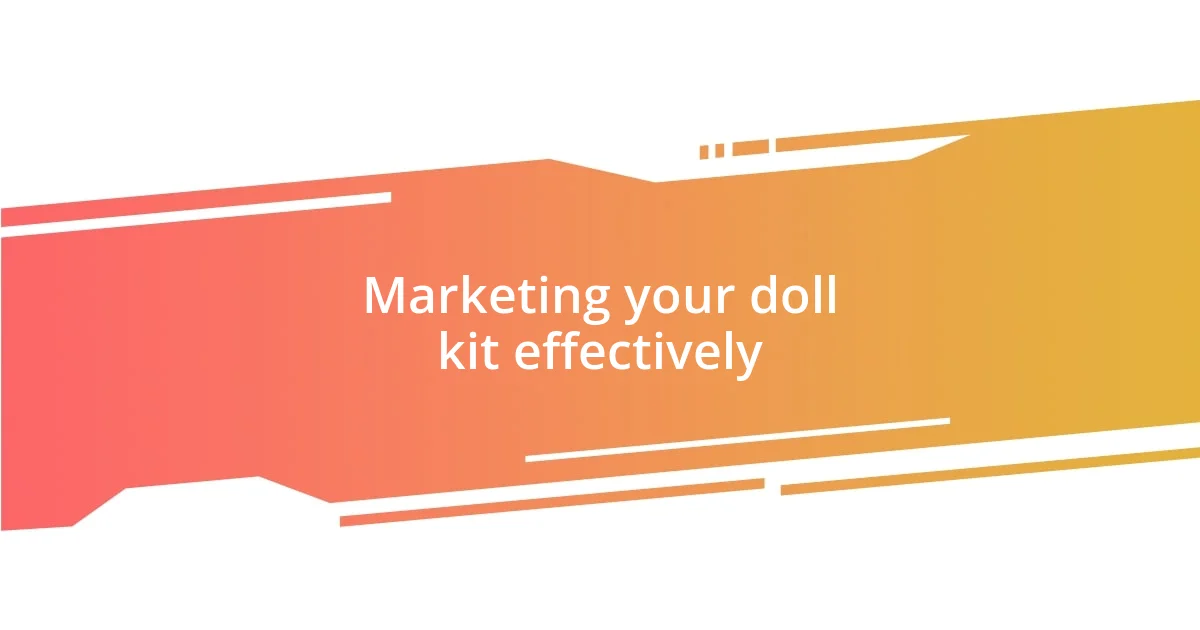
Marketing your doll kit effectively
Marketing your doll kit effectively requires a blend of strategy and authenticity. I learned early on that connecting with my audience on social media was essential. I vividly recall sharing snippets of my design process on Instagram and how the community responded with enthusiasm. It became a way for me to build relationships, and it felt rewarding to see people genuinely excited about something I poured my heart into. Have you ever noticed how much authenticity can shift perceptions?
Beyond social media, I found that collaboration can amplify your reach. I approached local artists and crafting influencers, inviting them to create unique designs using my kit. I still remember the first time a popular crafter showcased my doll kit in their video. The surge in interest was incredible! Collaborations not only provided fresh perspectives on my product but also expanded my audience. Isn’t it true that two creative minds can achieve so much more together?
I also focused on creating engaging content that provided value. Tutorials on how to use my kit, tips for customizing the dolls, and behind-the-scenes peeks truly resonated with potential buyers. I realized that weaving stories around my kits made them more than just a product—they became part of my audience’s crafting journey. Reflecting back, doesn’t it make you think about how much more impactful a narrative can be than simply selling an item? Every piece of content was a chance to ignite passion and creativity in others.
